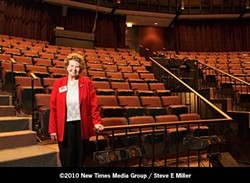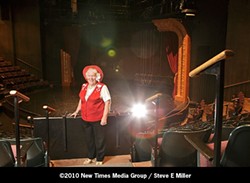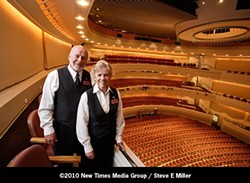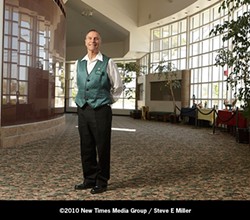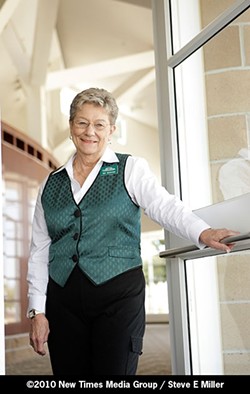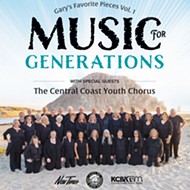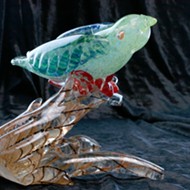[{
"name": "Ad - Medium Rectangle CC01 - 300x250",
"id": "AdMediumRectangleCC01300x250",
"class": "inlineCenter",
"insertPoint": "8",
"component": "2963441",
"requiredCountToDisplay": "12"
},{
"name": "Ad - Medium Rectangle LC01 - 300x250",
"id": "AdMediumRectangleCC01300x250",
"class": "inlineCenter",
"insertPoint": "18",
"component": "2963441",
"requiredCountToDisplay": "22"
},{
"name": "Ad - Medium Rectangle LC09 - 300x250",
"id": "AdMediumRectangleLC09300x250",
"class": "inlineCenter",
"insertPoint": "28",
"component": "3252660",
"requiredCountToDisplay": "32"
}]
They’re the people who spend their weekends passing out programs and decoding seating charts, ambassadors of multimillion-dollar performance venues. They are the first line of defense, parting theatergoers from six packs and purse dogs. While on duty, they wear red, black, or green vests, according to venue, and a strict uniform consisting of black pants and white shirts. They’re ushers. They’re volunteers. And they’ve got stories to tell.
Doris Bynum was a season subscriber at PCPA long before she began volunteering in 2005. She started attending the theater’s plays with her late husband, until he became too sick to attend and insisted that she go with her friend instead. Together, they subscribed to each PCPA season for almost a decade. Then, her friend died and Bynum lost interest in attending live theater as an audience member. She saw a brochure advertising for volunteers and decided to try her hand at ushering.
“I thought I could try this,” she said. “I’ve always liked live plays. It’s kind of fun being the first person that the patrons see when they come in.”
Her affinity for live theater first developed when she was a child. She grew up in Stockton, which was on the live-theater circuit. Back then, the movies were silent, with subtitles, but Bynum couldn’t yet read. To her, movies were “just dumb action on the screen.”
Ushers at PCPA have a long list of responsibilities, including handing out programs, working the concession stand, and directing people to their proper seat. The latter is a task rarely assigned to Bynum because she’s in her mid-‘80s now and not steady enough on her feet to manage the long, steep rows of stairs.
She accomplishes all of these tasks in the standard black pants or skirt—“they can be navy blue but they prefer black,” she confides—paired with a white top and red jacket or vest. “Usually the fellows wear a tie,” she adds. “And they look best when they do.”
Besides greeting and assisting the patrons, ushers are sometimes faced with the disagreeable task of enforcing rules. When asked whether patrons ever break these rules, Bynum chuckles out an “oh yeah.” Perhaps the most commonly violated rule is the prohibition against food and beverages in the theater.
“You have to tell people to put it away or discard it,” she narrated. “People will say they’ll put it in their purse but we can tell from tell-tale signs afterwards that they didn’t. No matter how careful they are they always make a mess.”
Every once in awhile people will arrive at the door with children under the age of five in tow, forcing the ushers to call the house manager. And on one particularly memorable occasion someone tried to bring a dog into the theater.
“The house manager at that time was a tall young fellow and he had to tell them the dog couldn’t come in. And they informed him it didn’t say on the ticket. Of course, that’s kind of an unwritten rule,” she laughed.
Since relocating to Santa Maria in 2001, Anderson has made a point of filling her days with charitable causes. She spends Mondays at the Santa Maria library, Wednesdays and Thursdays at Vandenberg Air Force Base, and most Fridays at the theater.
Like Bynum, Anderson prefers the theater’s comedies, and for much the same reason. Anderson said, “you want to go where you can laugh and have fun and not feel down” and Bynum commented that “life’s serious enough.” And when the ushers are lucky, and happen to be working at the doors, they get to watch the production along with the audience.
“But that doesn’t mean you’re going to see the play uninterrupted,” warns Anderson. “Because if somebody wants out, and usually several do, you have to let them out.”
When the audience is utterly still, and quiet, Anderson knows that they are completely transfixed with a production. She’s in a rare position to watch both the play and audience, and develop an understanding for the latter’s moods and whims.
“The most difficult part is dealing with people, being able to see that the rules are followed without upsetting people or making them feel unwelcome,” she explained. “Fortunately, most people are nice. Of course, as an usher we represent the college. Especially the first-time people, they’re going to judge the college by the way they see us as ushers.”
Anderson adds taking pictures to the list of prohibited activities that ushers have to watch out for. And beer is a prohibited item visitors sometimes attempt to smuggle into the theater.
The former schoolteacher distinguishes herself from the other ushers with a cherry-red hat she adds to the standard uniform. And her vest is heavy with flair.
Sharynn and Jerry Chirpich have been ushering since the Performing Art Center’s opening night in the summer of 1996. Previously the retired couple had ushered at Cuesta College’s performances and events, but they liked the idea of being involved in a project at the ground floor, and so began volunteering at the new venue.
The pair has been working the venue so long they know all the rules and tricks of the ushering trade. Be careful where you shine your light, warns Jerry. The dress code consists of a white shirt or blouse, nametag, and black pants, shoes, socks, ties, and vests. No dangling earrings and no strong perfume. They have the seating maps memorized; some rows seat 40, some seat 50, and some 15, confounding a lesser-experienced usher.
In fact, the couple is so tough that when watermelon-smashing comedian Gallagher came to town, they were placed in the front lines.
“We had plastic all over the seats for the first 10 rows,” described Jerry. “People came to this and they take plastic and ponchos because they know they’re going to get splattered. And the floor gets slippery. It was awful.”
Ushers at the PAC are asked to serve at four shows a quarter, totaling a minimum of 24 a year. After 15 years of ushering, that adds up to at least 360 shows that the couple have attended as volunteers. Sharynn is responsible for selecting the performances; all volunteers indicate which they would most like to work to ensure scheduling is fair. Using this method, Jerry isn’t always certain what type of event he is working until he arrives. When Sharynn signed them up for the senior showcase, for example, he thought he was going to watch senior citizens perform. Instead, the event turned out to be a showcase put on by seniors at the Grizzly Academy. He starts to tear up as he describes how one student began to cry while explaining that he was the first in his family to graduate high school.
“And it was an event that we never would have seen,” he said poignantly.
Sometimes they set up folding chairs in the back of the theater to watch the show. It’s rare for them to sit on the stairs to watch, but that happens as well. From this perch, the ushers can swoop down on a kid playing a video game or an audience member who insists on talking on their cell phone. The duo’s favorite assignment is taking tickets because it affords them the opportunity to greet people as they come in. Sometimes, manning the elevator is the best task. At least, that was the case when singer Tom Jones came to town.
“For some crowds the elevator is really busy because of the age. That was the best show to work the elevator,” laughed Sharynn. “Daughters were taking their mothers, and the ladies were really funny. ‘Oh, he’s still got it. Do you have an extra pair of panties in your purse?’”
Watching the audience’s reaction enhances the show, they insist. Sure, they occasionally get a few people who leave before the show concludes because the sound is too loud or they maybe didn’t realize what they were in for when they purchased their tickets. But Sharynn prefers ushering a show specifically because she gets to share the audience’s enthusiasm. As an isolated individual she misses out on that shared experience.
And, of course, there’s a sort of pride in being able to have an impact on people’s overall experience.
“John Davidson came through,” narrated Sharynn. “He came out as we were getting our instructions and he said, ‘you’re the opening act.’ And I thought ‘you know, we are.’ We can set the tone, I think, for a person’s experience.”
Arroyo Grande resident Pete Giambalvo has been supportive of the Clark Center Foundation since before there was even a center to support. In 1993 he and his wife Mary agreed to serve as chairpeople for the promotions committee, dedicated to raising funds and promoting the center. And when the center opened in May of 2002, Giambalvo began volunteering in a new capacity—as an usher.
In fact, Giambalvo’s been serving so long and well that he is now one of the center’s usher captains, which means that on a given performance night he’s responsible for between 9 and 24 fellow volunteers. He arrives half an hour before anyone else, turns on the lights, and conducts a briefing with the rest of the ushers when they arrive to describe any event irregularities and assign their positions. And he’s trained for both CPR and first aid.
Giambalvo often constructs props and sets for annual Clark Center galas and fundraisers as well. The most recent were cowboy silhouettes and saloon doors for their May gala.
“My additional responsibility is to make sure that my volunteers enjoy what they are doing,” he said proudly. “Consequentially, I never have a problem with volunteers. I treat them extra special. My routine is when they come in I greet them all. I give them a briefing and I end with a joke. I’ve even had one usher tell me ‘I don’t come to usher, I come to hear your joke.’”
Usher attire is pretty similar to that worn by volunteers at the PAC and PCPA, except that Clark Center ushers pair their black and white garb with a Kelly green vest.
Over the years, Giambalvo has learned some important and unexpected lessons. For example, whenever there is a production that incorporates dry ice, the air-conditioning system is temporarily turned off. This wasn’t always the procedure. At least, it wasn’t until the dry ice got sucked into air conditioning unit and set off the fire alarm during a show. They managed to empty the center in three minutes, but decided that in the future it would be better if the audience could remain seated until the show concluded. Or at least until intermission.
Giambalvo’s also experienced a number of canine adventures featuring patrons that try to carry dogs into the theater in their purses. Center policy prohibits pets, with the exception of seeing-eye dogs. But that doesn’t stop people from trying to bring their pets.
“I have to remember that this is a person who is going to tell other people how they were treated,” Gimbalvo said of handling potentially sticky situations. “So I have to explain that this is a theater that does not allow dogs.”
Generally, though not always, Giambalvo finds himself interacting with more mature audiences. The theater seats 640, Giambalvo points out, which is large enough to serve the community but not necessarily big enough to draw headliners. Instead, many of yesteryear’s headliners grace the stage, drawing audiences with fond memories of the entertainers.
“When you retire and you’re used to working your whole life, it seems like a good way to fill your time,” she explained. “I think there’s a pride factor in saying you volunteer for something you consider worthwhile.” (Besides serving as an usher, Edminston volunteers for PCPA, the Central Coast Wine Classic, and World of Pinot Noir)
Edminston has noticed a recent trend of moving away from strict enforcement of certain rules—like the ban on chewing gum—in favor of a more relaxed environment. The chewing gum rule was particularly difficult to enforce, explained Edminston, because patrons would say they had swallowed their gum but would be spotted chewing it several minutes later. New rules also allow the patrons to bring bottled water into the theater.
Besides interacting with audiences, Edminston works hospitality backstage, which means that she has the opportunity to meet the entertainers.
“Most of them are really nice,” she said. “It’s kind of interesting to see that they’re just people. They just have that star next to their name.”
For every eight shows the Clark Center ushers work they receive one complimentary ticket. Those tickets come in handy, particularly because the ushers are often too busy to watch the show that they’re working.
“I do look at it as a volunteer job,” explained Edminston. “I know probably there are a lot of people who volunteer because they get to see the shows. I see that as secondary.”
Arts Editor Ashley Schwellenbach can be reached at [email protected].

